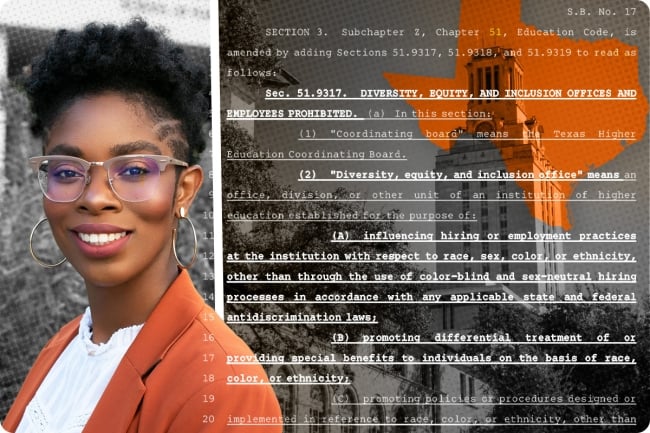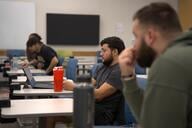You have /5 articles left.
Sign up for a free account or log in.

Months after SB 17 went into effect in Texas, UT Austin laid off several staff members who previously worked in DEI on campus, including Shawntal Z. Brown, pictured above.
Photo illustration by Justin Morrison/Inside Higher Ed | Shawntal Z. Brown | RoschetzkyIstockPhoto/iStock/Getty Images | Texas Senate
The University of Texas at Austin made headlines in April when it laid off approximately 60 staff members, most of them in diversity, equity and inclusion–related roles, in what the institution called an effort to comply with SB 17, the state’s new anti-DEI law. Though it was far from the only university impacted by DEI bans nationwide, most other institutions retained their DEI office staff in new roles or eliminated only a small number of positions. UT Austin’s decision was also noteworthy because it came months after the ban went into effect.
Shawntal Z. Brown, a UT Austin employee of seven years as well as a graduate student pursuing her Ph.D. in educational leadership and policy at the university, was one of the individuals affected. In an interview with Inside Higher Ed, Brown shared her experiences leading up to the implementation of SB 17 and the subsequent layoffs. This interview has been edited for length and clarity.
Q: What did your previous job entail?
A: I was mostly focused on bias response. My office was trying to [support] folks who are experiencing that type of discrimination, in addition to folks who wanted to make sure that their classrooms or their work environment or their interactions with their peers are inclusive, making sure folks felt a sense of belonging at the institution.
Q: When it became evident that offices were closing and things were going to change, what did the university initially tell you?
A: I would say from an institutional viewpoint, not much. From the president, we didn’t really have that type of conversation with him. I know my supervisor and folks who are in different areas were talking more with the legal team. We had more conversations with the vice president of our division.
I felt like there was a disconnect in some way, of hearing from the president himself with what he was wanting to do or what the vision was, and I felt like in real time, that [was] missing. That’s kind of a disappointment; I wish there was more conversation there.
Q: UT Austin got a lot of attention for being one of the few that let a lot of staff go as a result of this. Was there worry that that was going to happen?
A: It took me by surprise; I think it took all of us by surprise. I think for folks that I was close with, [including some] senior leaders, there was a lot of trust that the president or the administration wouldn’t go in that route [and would] really try to retain us. I always told people, “The division is about 20 years old, and so it’s been a pretty big staple at the institution. So, it would be pretty profound if that happened to us.”
But when that did happen, I think it was just a shock, because I think we thought we were going to be safe in some way. It just really came abruptly that that was going to be the end of it.
Q: How did you find out?
A: They used our VP’s email to put the invite on our calendars, and so, you would imagine, “Oh, yeah, that’s our VP maybe wanted to chat with us about something.” And then our HR department leaders are in there, and then they tell us all [that] we’re being let go.
It was definitely like a gut punch of, “Wow, I, one, didn’t expect that this was going to be the end of our division in this way and then also the end of our positions, because I’ve been at UT a little less than 10 years.” I was like, “Wow, this is really heartbreaking to, I guess, essentially be collateral amid all of the political pressures.”
Within the way the HR team facilitated it, it just was not adequate care, in my opinion. The meeting lasted like six minutes of them telling us that we were being let go. It was just something where I was like, there wasn’t any care, or [there was] just a lack of intentionality behind the whole process of letting us go. Later that day the institution sent out a letter about what happened. People didn’t understand the grandeur of, this means staff is gone. People were reaching out to us individually and asking like, “What does this mean?” And we had to tell them, “This is what it means.” So it was very much done in a way that just wasn’t thoughtful, and I think that really definitely just hurt.
Q: From your perspective, was it necessary to close offices and centers to comply with the new law? Did the university make an attempt to preserve anything or is there a sense that they sort of took the easiest way out?
A: I don’t know if there were efforts to really try to preserve the offices within the division, unfortunately. I feel that there was an opportunity to do so. With the pressure that the president felt from the bill author, I felt like that was probably the easiest route, to get rid of it all. But I think there could have been a lot of potential in having certain offices shifted around and moved around, because essentially, that was what they did. A lot of offices that were under the division [were moved] into other spaces, and I feel like all units could have been saved in that same way.
But I don’t know if that was really thought of, because we were moving so quickly to try to be compliant and try to move forward and kind of still attempt to do the same work.
Q: Do you think the renamed centers are a good solution? Do they do a good job of preserving the work of the offices that have been closed or do you worry that they could be watering down that work?
A: For me, it’s a yes and a no. I know in certain spaces, the staff that were formerly doing equity work were able to be retained and that’s really great and I’m glad they were. [They’re] just making their missions a bit more expansive.
But it doesn’t necessarily get at why these offices were created in the first place. Institutions were predominantly white, and they needed these spaces to recruit and retain underrepresented student populations. I think that is something where there might be some tension moving forward with these offices of like, how can you still recruit these students and engage with the students and provide programming and still kind of have that same effect or maybe a similar effect?
All I’m really saying is, it’s complicated. I think it makes it really hard within higher education to still keep the integrity of the spaces, and then also be protective of these spaces at the same time.
Q: Did the experience of losing your job because of DEI bans influence how you’re thinking of your future career? Are you worried about going back into a similar role in the future?
A: A yes and a no. I think I’m just nervous about what’s next. I know here in Texas, faculty senates [are] on the docket for the next legislative session. What does that look like for folks who might be wanting to do DEI in a professor context? And that is kind of a scary thought. So, I think in some ways, it makes [me hesitate] to go into a different role.
But I’m also trying to find roles and spaces that, at least, if I can’t do the work directly, I can do it adjacently. So maybe it’s me working with a specific population, maybe it’s me doing something more in the city or nonprofit, and maybe it’s not in education at all or something education-adjacent. But I think there are ways that I could probably show up in spaces that are still related to the work I want to do. But I’m just trying to think more broadly about where I could do it.
Q: A lot of campuses in red states across the country have closed DEI offices. An argument I often hear against cultural centers is that it’s discriminatory to have a space that is for one type of person and not have something equivalent for another. What are your thoughts on that?
A: It’s two prongs. In a cultural center space, or in a DEI-specific space, I’ve been telling folks, these are spaces that are truly meant for everyone. I think in the case of like, underrepresented students, whether it be LGBTQIA [students], women students, Black students, first gen—it’s just because these students are the ones who realize that they need support, they have needs, and they recognize these spaces as resources, and they will show up to them to help themselves.
In addition, these cultural spaces have developed because of students and their way of protesting and wanting to have these spaces. The university started out as just white men going into these institutions, and so, that in and of itself has taken so many years for different populations, groups, identities, to even be at an institution. These spaces are so, so important for these student groups. I always like to re-emphasize to people, just because you see a certain group or population in that space doesn’t mean you can’t come into it.
I think how you come into those spaces matters, too—if [you] come in with a whole different perspective, wanting to engage and learn, wanting to genuinely be there, versus having that intent behind it to be disruptive or rude or inappropriate, that would be different. It’s how you introduce spaces that really matters and to understand the history as to why those spaces were created.
Q: What do you see as the path forward from here? Is this going to be sort of the new normal, where colleges don’t have cultural centers and have to find ways to incorporate the resources elsewhere on campus? Or do you see other solutions for building this back?
A: I feel like there’s some type of student protest, or some type of student outcry that will probably happen in the future. [Right now], we’re able to see, the immediate aftermath of all this anti-DEI legislation is people really saying, “I’m hurting, I lost a mentor, lost a class I really love, I lost a space that I really enjoyed being in, or graduation’s not the same.” I hate to have to be this way, but you have to see … the impact in campus climate surveys, or the [amount] of discrimination is higher, now, or we’re not getting as much money, or our retention rates are dropping. I think those tangible numbers and that data has to inform why this is a problem. And then maybe something of a solution can come from it.
I think there have been some solutions to the problem with the expansion of certain offices and what they do with the programming, but I think the larger issue of sense of belonging will definitely show itself. And I feel like those in order for whatever future office will come out of all of this to be present, I think those tangible numbers and data will definitely come first and then the outcry to be able to kind of swing back in that way of getting those spaces again or some type of version of it.




